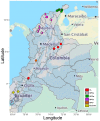Mitochondrial DNA Variations in Colombian Creole Sheep Confirm an Iberian Origin and Shed Light on the Dynamics of Introduction Events of African Genotypes
- PMID: 32911657
- PMCID: PMC7552328
- DOI: 10.3390/ani10091594
Mitochondrial DNA Variations in Colombian Creole Sheep Confirm an Iberian Origin and Shed Light on the Dynamics of Introduction Events of African Genotypes
Abstract
The genetic origins and diversity of Creole sheep from five regions of Colombia were investigated based on mitochondrial DNA (mtDNA) variations across 89 sequences from five breeds: one wool Creole sheep (CL) and four hair Creole sheep, including Ethiopian (OPCE), Sudan (OPCS), Pelibuey (OPCP) and Wayúu (OPCW). A global comparison was done using 62 haplotypes from Iberian, African, Indian, Caribbean, Mexican, Caucasian and European sheep based on sequences retrieved from GenBank. This study aimed to identify the maternal origin of Colombian Creole sheep and their genetic relationships at a global level. The results showed 31 different haplotypes from Colombian Creole sheep, which can be assigned to maternal lineage B, the most common lineage found in European sheep breeds and the only one found in several Iberian breed (e.g., Churra, Spanish Merino) that most likely participated in the Creole formation. Additional analyses showed that wool and hair sheep retained a broad genetic identity despite being geographically separated. The global-level phylogenetic analysis revealed that Colombian Creole sheep belong to a distinct and defined genetic lineage that is likely the result of a founder effect with ecotypes of Iberian descent and the subsequent introduction of foreign breeds. This is consistent with historical reports on the presence of sheep in South America and, particularly, Colombia.
Keywords: Creole sheep; haplotype; maternal heritage; mitochondrial DNA.
Conflict of interest statement
The authors declare no conflict of interest. The funders had no role in the design of the study; in the collection, analyses or interpretation of data; in the writing of the manuscript or in the decision to publish the results.
Figures





References
-
- Delgado J.V., León J.M., Gomez M., Nogales S., Camacho M. Las razas ovinas ibéricas y su participación en la colonización de Iberoamérica. In: Delgado J.V., Nogales S., editors. Biodiversidad Ovina Iberoamericana—Caracterización y Uso Sustentable. Universidad de Córdoba; Córdoba, Andalucía, Spain: 2010. pp. 17–30.
-
- Peña S., Martínez A., Villegas Castagnasso E., Aulicino M., Género E., Giovambattista G., Martínez R.D. Caracterización genética de cuatro poblaciones de ovinos criollos de Argentina. J. Basic Appl. Genet. 2017;28:43–55.
-
- Perezgrovas R., Parés P.-M., Hummel J., Zaragoza L., Delgado J.V. Características de la lana en 4 razas de ovejas autóctonas de España y México. Actas Iberoam. Conserv. Anim. 2011;1:380–383.
Grants and funding
LinkOut - more resources
Full Text Sources

